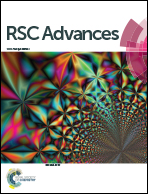Influence of Mn dopants on the electrical properties of Pb(In0.5Nb0.5)O3–PbTiO3 ferroelectric single crystals
Abstract
In order to study the influence of Mn doping on the electrical properties of PIN–PT single crystals and develop the materials for high power applications, relaxor-based 0.68Pb(In0.5Nb0.5)O3–0.32Pb(Ti0.92Mn0.08)O3 (Mn-PIN–PT) ferroelectric single crystals with pseudo-cubic symmetry were grown via the conventional flux method. The Mn-PIN–PT crystals have a Curie temperature (TC) of 231 °C and ferroelectric phase transition (TMPB) of 175 °C. Relaxor behavior is identified by the frequency dispersion in dielectric spectra. The piezoelectric coefficient and longitudinal electromechanical coupling factor (k33) are 730 pC N−1 and 80% at room temperature, respectively. The temperature coefficient of k33 is 1.6%, showing good stability up to 180 °C. The ferroelectric properties were measured at different electric fields, showing well-shaped hysteresis loops above 20 kV cm−1. The variation of remnant polarization (Pr), coercive field (EC) and internal bias field (Ei) as a function of temperature was investigated. The Curie temperature and ferroelectric phase transition temperature were decreased and increased, respectively, due to Mn doping, and a typical hard doping effect was confirmed via ferroelectric, dielectric and piezoelectric characterization.



 Please wait while we load your content...
Please wait while we load your content...